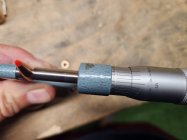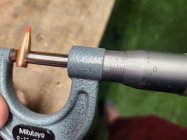I'm working up specs to have a 223AI reamer made up for me. I know what I want for all dimensions, based on my brass and FL die. However, I'm at a crossroads when it comes the the diameter in the throat/freebore.
You see, I've had problems on two chamberings in a row, a 22BR and 6Dasher, whereby I had throat/FB diameter that was too tight. Once things started getting dirty, the bullet would have to scrape it's way through (I could see scaping on all sides of bearing surface) in order for me to close the bolt; in one instance, it became so tight that it was seating the bullet back due to contact in the throat area (yes, it was very hard to close the bolt). The issue would be expedited when shooting ball powders (faster carbon accumulation in the the throat) and exaggerated when shooting fat bullets (I've found many bullets, especially Vmax, are being made "fat", with a diameter .0003 (or more) greater than other bullets I measure).
In looking for reamer specs for my 223AI, I searched far and wide for reamer prints, including standard 223 reamer prints, to view the throat diameter. I found an equal spattering ranging from .2240 - .2245 (I foundmany at .2240 and .2242); my question is...if you actually get a .2240 or even a .2242 and it "actually" comes out to that dimension, how would you even chamber a bullet as soon as you fire some rounds down the barrel or if you find yourself with fat bullets. I'm perplexed. In the name of chasing accuracy, have we simply gone too far?
This is a varmint chambering, so I was thinking I wanted something more like .2248 (giving me .0008 relief, or .0005 for 53 Vmax I plan to use), but I can't find a single print with a diameter this "large". What am I missing?
Attached are pics of the 53 Vmax measuring .2243 (Note: I have many other 22 cal bullets that measure exactly .2240 with my micrometer)
You see, I've had problems on two chamberings in a row, a 22BR and 6Dasher, whereby I had throat/FB diameter that was too tight. Once things started getting dirty, the bullet would have to scrape it's way through (I could see scaping on all sides of bearing surface) in order for me to close the bolt; in one instance, it became so tight that it was seating the bullet back due to contact in the throat area (yes, it was very hard to close the bolt). The issue would be expedited when shooting ball powders (faster carbon accumulation in the the throat) and exaggerated when shooting fat bullets (I've found many bullets, especially Vmax, are being made "fat", with a diameter .0003 (or more) greater than other bullets I measure).
In looking for reamer specs for my 223AI, I searched far and wide for reamer prints, including standard 223 reamer prints, to view the throat diameter. I found an equal spattering ranging from .2240 - .2245 (I foundmany at .2240 and .2242); my question is...if you actually get a .2240 or even a .2242 and it "actually" comes out to that dimension, how would you even chamber a bullet as soon as you fire some rounds down the barrel or if you find yourself with fat bullets. I'm perplexed. In the name of chasing accuracy, have we simply gone too far?
This is a varmint chambering, so I was thinking I wanted something more like .2248 (giving me .0008 relief, or .0005 for 53 Vmax I plan to use), but I can't find a single print with a diameter this "large". What am I missing?
Attached are pics of the 53 Vmax measuring .2243 (Note: I have many other 22 cal bullets that measure exactly .2240 with my micrometer)













